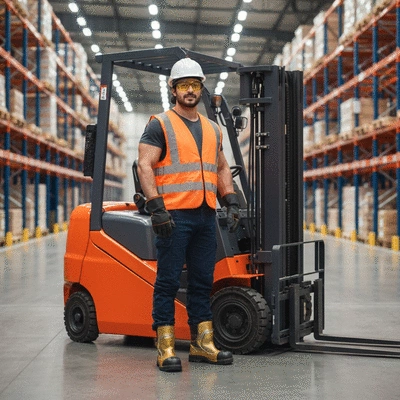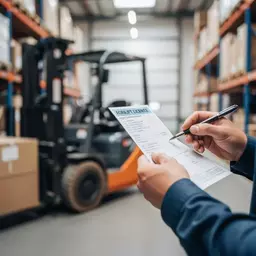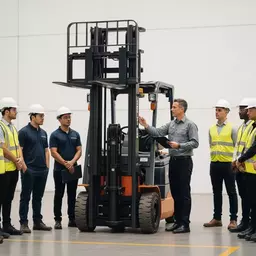Safety is not just a requirement; it’s a culture that can transform your work environment. In the world of forklift operation, Personal Protective Equipment (PPE) is the first line of defense against workplace hazards. Let’s delve into the crucial role that proper PPE plays in maintaining safety and reducing risks.
What You Will Learn
- Critical Role of PPE: PPE significantly reduces the risk of injuries among forklift operators.
- Types of Essential Gear: Hard hats, steel-toed boots, and gloves are vital for protecting against common hazards.
- Promoting a Safety Culture: Wearing PPE fosters accountability and sets a safety standard for all team members.
- Importance of Risk Assessment: Regular evaluations help identify hazards and ensure the correct PPE is used.
Key PPE for Forklift Operators
This visual outlines the essential Personal Protective Equipment (PPE) crucial for maintaining safety during forklift operations, categorized by the area of protection and its primary benefit. For a deeper understanding of overall safety, explore these forklift safety rules for operators.
Head Protection: Hard Hats
Safeguard against falling objects and impact from overhead hazards.
Foot Protection: Steel-Toed Boots
Protect feet from heavy loads, punctures, and provide support on uneven surfaces.
Eye Protection: Safety Glasses
Shield eyes from dust, debris, and chemical splashes in the work environment.
Hand Protection: Gloves
Enhance grip on controls, protect hands from cuts, abrasions, and extreme temperatures.
Visibility Gear: High-Visibility Vests
Increase operator visibility to pedestrians and other vehicle operators in busy areas.
Hearing Protection: Ear Plugs/Muffs
Safeguard against long-term hearing damage from excessive noise exposure in industrial settings.
Understanding the Importance of PPE for Forklift Operators
As a forklift operator, safety should always be your top priority! Personal Protective Equipment (PPE) plays a crucial role in ensuring your safety while you navigate the bustling environment of a warehouse or construction site. Not only does PPE protect you from hazards, but it also promotes a culture of safety in the workplace, which is vital for everyone involved. Let's explore why PPE matters and how it can safeguard you from potential risks.

Why Personal Protective Equipment Matters in Forklift Operations
PPE is designed to protect workers from injuries caused by workplace hazards. In the context of forklift operations, the equipment you wear can mean the difference between a safe day at work and a potential accident. By wearing appropriate PPE, you not only protect yourself but also set a standard for your fellow operators.
- Enhances Safety: Proper PPE minimizes the risk of injury from various hazards.
- Boosts Confidence: Wearing safety gear helps operators feel secure and focused, allowing them to perform their duties effectively.
- Promotes Accountability: A commitment to PPE encourages a culture of safety within the entire team.
At Forklift Licence Insights, we believe that understanding the importance of PPE is a vital step in your forklift licensing journey. This knowledge not only prepares you for the licensing process but instills a safety-first mindset that you'll carry into your career. For more information on securing your certification, consider our guide on getting your forklift licence in Australia.
Common Risks Faced by Forklift Operators Without Proper PPE
Each day, forklift operators face various risks that can lead to serious injuries or accidents. Without the right protective gear, you may expose yourself to:
- Falling Objects: Hard hats are essential to protect your head from items that may drop from shelves or other heights.
- Slips and Falls: Steel-toed boots provide necessary support and protection for your feet, preventing injuries from heavy loads.
- Cuts and Bruises: Gloves can enhance your grip while protecting your hands from sharp edges or hot surfaces.
Understanding these risks can help you appreciate the necessity of PPE. It’s not just about compliance; it’s about keeping yourself safe while operating a forklift.
The Role of Risk Assessment in Forklift Safety
Risk assessment is a proactive approach to identifying potential hazards in your workplace and determining the appropriate PPE needed for specific tasks. Conducting regular assessments ensures that you’re aware of the unique risks associated with forklift operations in your environment.
- Identify Hazards: Take time to review your work area and look for risks such as uneven surfaces or overhead loads.
- Evaluate Risks: Assess the level of risk associated with each hazard to determine what protective measures are needed.
- Implement Solutions: Based on your findings, ensure that you and your colleagues wear the correct PPE while operating forklifts.
By integrating risk assessments into your daily routine, you reinforce the importance of safety on the job. Remember, at Forklift Licence Insights, I’m here to guide you through this crucial aspect of forklift operation, ensuring that you are well-informed and prepared.
Pro Tip
Did you know? Regularly inspecting your PPE for damage can significantly enhance your safety on the job. A quick checklist can include checking for frayed straps, cracks in hard hats, or worn-out gloves. By ensuring your equipment is in top condition, you not only protect yourself but also set a strong example for your colleagues!
Summarizing the Critical Role of PPE in Forklift Safety
As we wrap up our discussion on the importance of Personal Protective Equipment (PPE) for forklift operators, it’s clear that proper gear is not just a regulatory requirement but a cornerstone of workplace safety. Implementing the right PPE can significantly reduce the risk of injuries and create a safer working environment. Remember, safety starts with you!
To ensure you’re on the right track, let’s recap the key types of PPE every forklift operator should prioritize:
- Hard Hats: Protecting your head from falling objects.
- Steel-Toed Boots: Offering safety and support for your feet.
- Safety Glasses: Shielding your eyes from potential hazards.
- Gloves: Enhancing grip while protecting your hands.
- High-Visibility Vests: Keeping you visible in busy areas.
- Hearing Protection: Safeguarding against excessive noise exposure.
- Face Shields: Providing additional face protection.
- Respirators: Protecting against harmful inhalants.
This list highlights the essential personal protective equipment that can contribute to your safety as a forklift operator. Always ensure your PPE is not just available, but also properly fitted and maintained!
Final Thoughts on Compliance, Training, and Safety Culture
Compliance with safety standards is vital for operating forklifts safely. Understanding these requirements can help you avoid penalties and, more importantly, protect lives. At Forklift Licence Insights, we emphasize the importance of ongoing training and fostering a safety culture within your organization. Everyone, from management to operators, plays a role in making safety a shared responsibility! For more details on compliance, see our article on navigating forklift licence compliance laws.
Moreover, training programs that include PPE awareness are critical. They empower operators to recognize hazards and understand how to mitigate risks effectively. By embedding safety practices into your daily operations, you can cultivate an environment where safety is prioritized. After all, a culture of safety is a culture of success!
Encouraging Safe Practices: Taking Action Towards Forklift Safety
Frequently Asked Questions About Forklift PPE
- What is PPE and why is it important for forklift operators?
- PPE stands for Personal Protective Equipment. It is crucial for forklift operators as it serves as the first line of defense against workplace hazards, significantly reducing the risk of injuries and promoting a safer work environment.
- What are the essential types of PPE for forklift operators?
- Essential PPE includes hard hats for head protection, steel-toed boots for foot protection, safety glasses for eye protection, gloves for hand protection, high-visibility vests for visibility, and hearing protection (earplugs/muffs) to guard against noise exposure.
- How does PPE enhance safety for forklift operators?
- PPE minimizes injury risks from various hazards like falling objects, slips, and cuts. It also boosts operator confidence by making them feel secure and focused, and promotes a culture of accountability and safety within the entire team.
- What role does risk assessment play in determining appropriate PPE?
- Risk assessment is a proactive process to identify potential workplace hazards and evaluate the level of risk associated with each. This helps determine and implement the correct PPE needed for specific tasks and environments, ensuring operators are adequately protected.
- Why is it important to inspect and maintain PPE regularly?
- Regular inspection of PPE for damage (e.g., frayed straps, cracks in hard hats, worn-out gloves) is vital. Ensuring equipment is in top condition enhances safety, as damaged PPE may not provide adequate protection, and it also sets a strong example for colleagues.
How to Get Started with Proper PPE Implementation
Ready to take the first steps toward ensuring your team is adequately equipped? Start by conducting a thorough assessment of your operation's specific needs. Here’s a quick guide:
- Identify potential hazards in your workplace.
- Choose appropriate PPE based on the identified risks.
- Provide training on how to properly use and maintain the PPE.
- Regularly review and update your PPE policies as needed.
Engaging your team in this process not only ensures compliance but also emphasizes the importance of safety in your workplace. Don’t forget to communicate the significance of wearing PPE consistently!

Resources for Forklift Operators on Safety Practices and Training
For ongoing education and resources, consider exploring the following:
- Local training organizations that offer forklift safety courses.
- Online platforms providing safety materials and PPE guidelines.
- Workshops and seminars focusing on forklift operations and safety.
These resources can help you stay informed and prepared. Remember, safety is an ongoing journey, and staying updated is key!
Understanding Workplace Hazards and Their Management
Finally, understanding the specific hazards associated with your forklift operations is crucial. Common hazards include:
- Pedestrian traffic around the forklift area.
- Uneven surfaces causing instability.
- Weather conditions affecting visibility and traction.
To manage these risks, engage in regular safety audits and encourage open communication among your team. Addressing hazards proactively can prevent accidents and ensure a safer environment for everyone involved. For a comprehensive overview, read about essential safety practices for forklift operators.
Recap of Key Points
Here is a quick recap of the important points discussed in the article:
- Importance of PPE: Personal Protective Equipment is essential for forklift operators to minimize injury risks and promote safety culture.
- Common Risks: Operators without proper PPE face hazards like falling objects, slips, and cuts, which can lead to serious injuries.
- Risk Assessment: Regularly identify and evaluate workplace hazards to ensure the correct PPE is worn during operations.
- Essential PPE Types: Key equipment includes hard hats, steel-toed boots, safety glasses, gloves, high-visibility vests, hearing protection, face shields, and respirators.
- Ongoing Training: Compliance with safety standards and continuous training are crucial to fostering a culture of safety among all team members.






